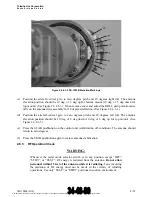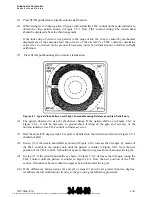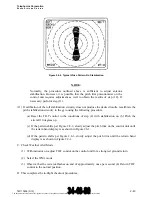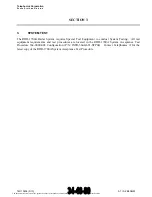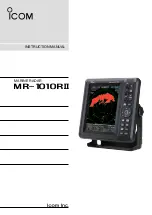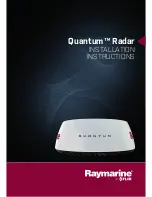
Telephonics Corporation
R
A D A R
S
Y S T E M S
D
I V I S I O N
TM113806 (3/10)
2-31
Shields on shielded wires should not be grounded to the airframe. Ordinarily, shields will be carried
through any obstruction via a thru-bulkhead connector and grounded internally to the R-T unit or
associated unit. If shielding cannot be carried through by use of a bulkhead/connector pin, precautions
should be taken to ensure that each segment of the shielded lead be grounded at only one point using a
ground connection of not more than two inches in length. The above consideration does not apply to
coaxial cable. Unbroken coaxial runs are preferable. If a break is necessary, use type BNC connector at
break.
2.5.4.2 Waveguide
A transmission line, composed of waveguide sections, must be installed in the aircraft. The waveguide
should be installed in as direct a path as possible between the R-T unit and the antenna.
NOTE:
Waveguide runs between transmitter and antenna should be designed for minimum length to avoid
unnecessary attenuation of the radar signal. Runs in excess of 10 feet are not recommended.
The following installation information is provided (for personnel not familiar with installing wave
guides in aircraft) to help devise a transmission line that will provide proper performance. If special
parts must be used to solve installation problems, the exact configuration of these parts should be
carefully determined during the mock-up. When a satisfactory mock-up system has been designed,
make a drawing to help describe the complete list of parts to be ordered. The drawing should indicate
the length and part numbers of the standard component sections of waveguide and should identify
special nonstandard components. Submit drawings with sufficient dimensioning to completely define
the nonstandard part when ordering such components. Observe the following points when using rigid
waveguide components:
Q
Use standard rigid components wherever possible.
Q
Minimize the number of joints in the waveguide run to minimize the overall VSWR value.
Q
Clamp rigid waveguide to a solid portion of the aircraft structure at least once in each 3 feet of
waveguide run.
Q
Use clamps so designed that they will not distort the waveguide walls.
Q
Before ordering nonstandard large radius waveguide bends, see if the same result can be obtained
by using standard bends with additional length in the straight sections.
Q
When specifying unavoidable special bends in rigid waveguide, use an exact radius of 2.214 inches
to the waveguide centerline for all sharp bends in either E or H plane, and 7 inches centerline radius
or greater in large bends. Each individual section of rigid waveguide should contain no more than
one bend. This procedure simplifies maintenance of the transmission line.
Q
Remember to allow sufficient clearance to permit access to flange connecting screws.
Q
Use waveguide quick disconnects wherever joints are to be broken repeatedly for maintenance,
inspection, or access to other equipment, or to ensure good joint sealing in relatively inaccessible
locations.
Q
Be certain that each joint in the waveguide run is made by the mating of a choke flange and a cover
flange. This type joint will permit proper RF sealing of the line. Each waveguide section should
The document reference is online, please check the correspondence between the online documentation and the printed version.





















